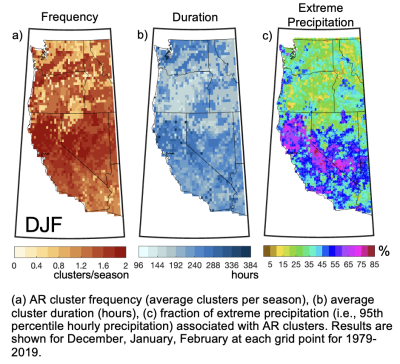Subseasonal Clustering of Atmospheric Rivers Over the Western United States
Scientists at the University of California, Los Angeles found atmospheric rivers (ARs) cluster over subseasonal timescales with statistical significance across the western US based on a comparison of observed AR occurrence against a randomly distributed AR time series with the same average event density. AR clustering is shown to vary geographically along the pronounced meridional precipitation gradient along the US West Coast.
The serial occurrence of ARs along the US West Coast can lead to prolonged and exacerbated hydrologic impacts, threatening flood control and water-supply infrastructure, due to soil saturation and diminished recovery time between storms. This study shows that ARs cluster more than expected due to chance suggesting dynamical mechanisms favor AR cluster development. The distinct statistically significant clustering timescales presented here can be leveraged to investigate the dynamics and synoptic environments that favor AR cluster development for improved predictability and situational awareness.
ARs, or long narrow regions of enhanced water vapor transport, are an important component of the midlatitude hydrologic cycle, responsible for producing precipitation and associated extremes. To better prepare for potential exaggerated impacts from the cascading effect of ARs occurring in close temporal proximity, we apply a statistical framework to identify the timescales at which wintertime ARs cluster at a rate different from what would be expected by random chance over the western US. Observed AR occurrence, compared against a randomly distributed AR time series with the same average event density, reveals temporal clustering at a greater-than-random rate across the western US, with a distinct geographical pattern. Compared to the Pacific Northwest, significant AR clusters over the northern Coastal Range of California and Sierra Nevada are more frequent and occur over longer time periods. Clusters along the California Coastal Range typically persist for 2 weeks, are composed of 4-5 ARs per cluster, and account for over 85% of total AR occurrence. Across the Northwest Coast-Cascade Ranges, clusters account for ~50% of total AR occurrence, typically last 8 to 10 days, and contain 3-4 individual AR events. Based on precipitation data from a high-resolution dynamical downscaling of reanalysis, the fractions of total and extreme hourly precipitation attributable to AR clusters are largest along the northern California coast and in the Sierra Nevada.

